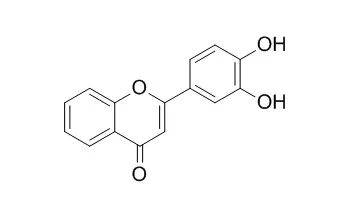| In vitro: |
| Biomolecules & therapeutics, 2018, 26(2):210-217. | | Synthetic 3',4'-Dihydroxyflavone Exerts Anti-Neuroinflammatory Effects in BV2 Microglia and a Mouse Model.[Reference: WebLink] | Neuroinflammation is an immune response within the central nervous system against various proinflammatory stimuli. Abnormal activation of this response contributes to neurodegenerative diseases such as Parkinson disease, Alzheimer's disease, and Huntington disease. Therefore, pharmacologic modulation of abnormal neuroinflammation is thought to be a promising approach to amelioration of neurodegenerative diseases.
METHODS AND RESULTS:
In this study, we evaluated the synthetic flavone derivative 3',4'-Dihydroxyflavone, investigating its anti-neuroinflammatory activity in BV2 microglial cells and in a mouse model. In BV2 microglial cells, 3',4'-Dihydroxyflavone successfully inhibited production of chemokines such as nitric oxide and prostaglandin E2and proinflammatory cytokines such as tumor necrosis factor alpha, interleukin 1 beta, and interleukin 6 in BV2 microglia. It also inhibited phosphorylation of mitogen-activated protein kinase (MAPK) and nuclear factor (NF)-κB activation. This indicates that the anti-inflammatory activities of 3',4'-Dihydroxyflavone might be related to suppression of the proinflammatory MAPK and NF-κB signaling pathways. Similar anti-neuroinflammatory activities of the compound were observed in the mouse model.
CONCLUSIONS:
These findings suggest that 3',4'-Dihydroxyflavone is a potential drug candidate for the treatment of microglia-related neuroinflammatory diseases. | | Journal of Microbiology & Biotechnology, 2010, 20(9):1359-1366. | | Characterization of an O-methyltransferase from Streptomyces avermitilis MA-4680.[Reference: WebLink] | A search of the Streptomyces avermitilis genome reveals that its closest homologs are several O-methyltransferases. Among them, one gene (viz., saomt5) was cloned into the pET-15b expression vector by polymerase chain reaction using sequence-specific oligonucleotide primers.
METHODS AND RESULTS:
Biochemical characterization with the recombinant protein showed that SaOMT5 was S-adenosyl-L-methionine-dependent Omethyltransferase. Several compounds were tested as substrates of SaOMT5. As a result, SaOMT5 catalyzed Omethylation of flavonoids such as 6,7-dihydroxyflavone, 2',3'-dihydroxyflavone, 3',4'-Dihydroxyflavone, quercetin, and 7,8-dihydroxyflavone, and phenolic compounds such as caffeic acid and caffeoyl Co-A.
CONCLUSIONS:
These reaction products were analyzed by TLC, HPLC, LC/MS, and NMR spectroscopy. In addition, SaOMT5 could convert phenolic compounds containing ortho-dihydroxy groups into Omethylated compounds, and 6,7-dihydroxyflavone was known to be the best substrate. SaOMT5 converted 6,7- dihydroxyflavone into 6-hydroxy-7-methoxyflavone and 7-hydroxy-6-methoxyflavone, and caffeic acid into ferulic acid and isoferulic acid, respectively. Moreover, SaOMT5 turned out to be a Mg2+-dependent OMT, and the effect of Mg2+ ion on its activity was five times greater than those of Ca2+, Fe2+, and Cu2+ ions, EDTA, and metal-free medium. | | The Korean Journal of Parasitology, 2014, 52(6):613-619. | | Flavonoids modulate the proliferation of Neospora caninum in glial cell primary cultures.[Reference: WebLink] | Neospora caninum (Apicomplexa; Sarcocystidae) is a protozoan that causes abortion in cattle, horses, sheep, and dogs as well as neurological and dermatological diseases in dogs. In the central nervous system of dogs infected with N. caninum, cysts were detected that exhibited gliosis and meningitis. Flavonoids are polyphenolic compounds that exhibit antibacterial, antiparasitic, antifungal, and antiviral properties.
METHODS AND RESULTS:
In this study, we investigated the effects of flavonoids in a well-established in vitro model of N. caninum infection in glial cell cultures. Glial cells were treated individually with 10 different flavonoids, and a subset of cultures was also infected with the NC-1 strain of N. caninum. All of the flavonoids tested induced an increase in the metabolism of glial cells and many of them increased nitrite levels in cultures infected with NC-1 compared to controls and uninfected cultures. Among the flavonoids tested, 3',4'-Dihydroxyflavone, 3',4',5,7-tetrahydroxyflavone (luteolin), and 3,3',4',5,6-pentahydroxyflavone (quercetin), also inhibited parasitophorous vacuole formation.
CONCLUSIONS:
Taken together, our findings show that flavonoids modulate glial cell responses, increase NO secretion, and interfere with N. caninum infection and proliferation. |
|






 Cell. 2018 Jan 11;172(1-2):249-261.e12. doi: 10.1016/j.cell.2017.12.019.IF=36.216(2019)
Cell. 2018 Jan 11;172(1-2):249-261.e12. doi: 10.1016/j.cell.2017.12.019.IF=36.216(2019) Cell Metab. 2020 Mar 3;31(3):534-548.e5. doi: 10.1016/j.cmet.2020.01.002.IF=22.415(2019)
Cell Metab. 2020 Mar 3;31(3):534-548.e5. doi: 10.1016/j.cmet.2020.01.002.IF=22.415(2019) Mol Cell. 2017 Nov 16;68(4):673-685.e6. doi: 10.1016/j.molcel.2017.10.022.IF=14.548(2019)
Mol Cell. 2017 Nov 16;68(4):673-685.e6. doi: 10.1016/j.molcel.2017.10.022.IF=14.548(2019)